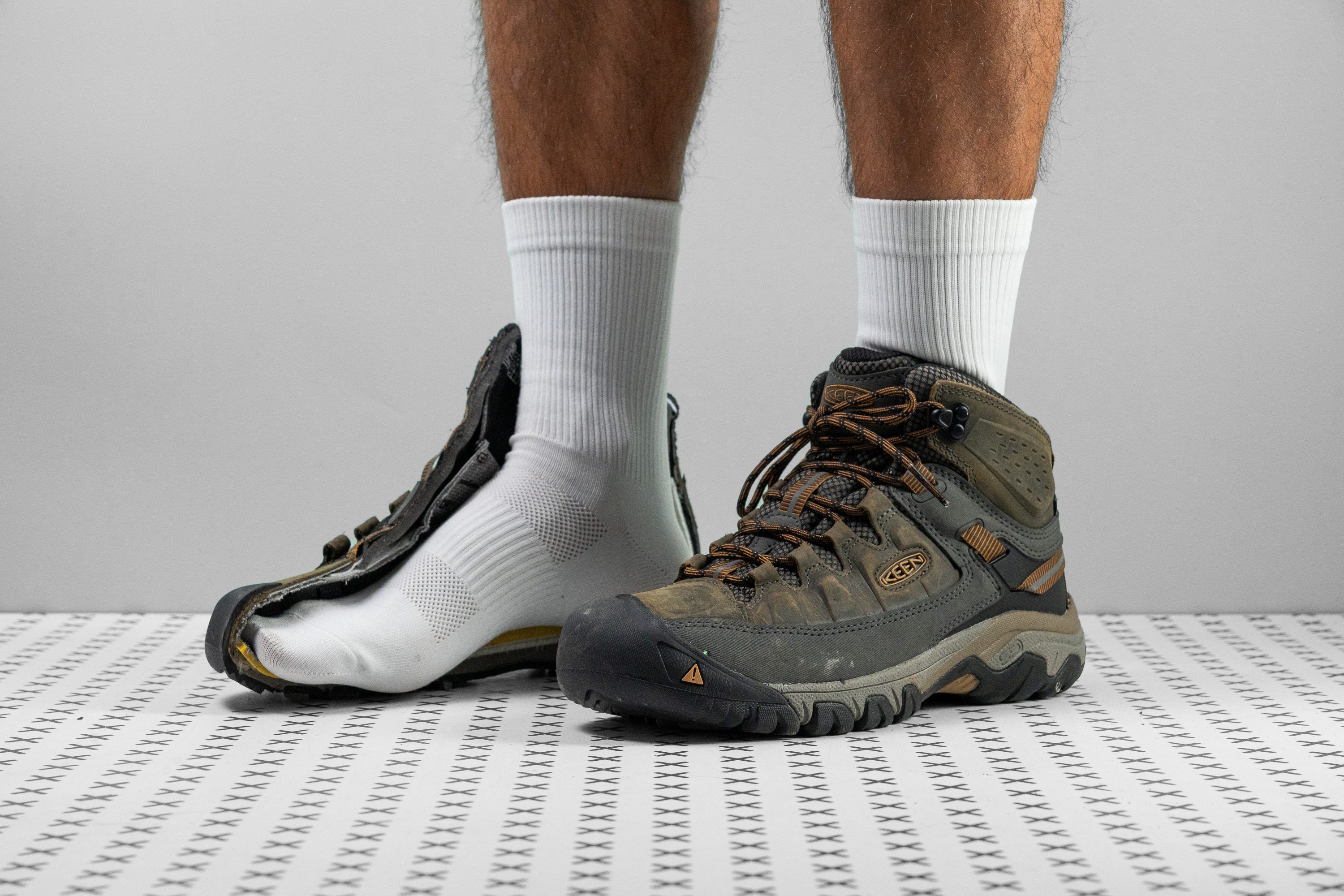Our verdict
- Our top pick in best snow hiking boots
- Our top pick in best hiking boots for wide feet
Pros
- Extremely stable
- Great ankle support
- Dec 21, 2023
- Secure heel hold
- Flexible
- Budget-friendly price
- Laudable warmth
- Performs very well in the cold
- Excellent grip on various terrain
- Short to zero break-in period
- Commendable toe cap
- Roomy toebox
Cons
- Stuffy in the summer
- Midsole softness in cold
- Firm midsole
- Not ideal for narrow feet
Audience verdict
Comparison
The most similar hiking boots compared
+ + Add a shoe | |||||
|---|---|---|---|---|---|
| Audience score | 85 Great! | 79 Good! | 81 Good! | 87 Great! | |
| Price | $165 | $229 | $185 | $200 | |
| Trail terrain | Moderate terrainTechnical terrain | Moderate terrainTechnical terrain | Technical terrain | Technical terrain | |
| Weight lab Weight brand | 18.2 oz / 515g 17.4 oz / 493g | 20.6 oz / 583g 20.6 oz / 585g | 15.5 oz / 440g 15.3 oz / 434g | 14.6 oz / 415g 16.6 oz / 470g | |
| Lightweight | ✗ | ✗ | ✓ | ✓ | |
| Breathability | Moderate | Warm | Warm | Warm | |
| Use | BackpackingDay HikingLight HikingSnow | BackpackingDay HikingSnow | Day HikingLight HikingSnow | BackpackingDay HikingSnow | |
| Foot condition | BunionsFlat feetPlantar fasciitis | Flat feetPlantar fasciitisOverpronation | Flat feetPlantar fasciitisOverpronation | Flat feetPlantar fasciitisOverpronation | |
| Orthotic friendly | ✓ | ✓ | ✓ | ✓ | |
| Drop lab | 12.9 mm | 14.0 mm | 11.2 mm | 14.1 mm | |
| Midsole softness | Firm | Balanced | Soft | Balanced | |
| oz / 434g | Small | Small | Normal | Normal | |
| Heel counter stiffness | Flexible | Moderate | Stiff | Moderate | |
| Stiffness | Flexible | Moderate | Flexible | Moderate | |
| Difference in stiffness in cold | Small | Normal | Big | Big | |
| Outsole hardness | Soft | Hard | Average | Very hard | |
| Waterproofing | Waterproof | Waterproof | Waterproof | Waterproof | |
| Material | Leather | Suede | - | Mesh | |
| Season | Winter | Winter | Winter | Winter | |
| Toebox durability | Good | Good | - | Good | |
| Heel padding durability | Decent | Decent | - | Decent | |
| Outsole durability | Bad | Good | - | Good | |
| oz / 515g | Wide | Medium | Narrow | Narrow | |
| Toebox width at the big toe | Wide | Narrow | Narrow | Medium | |
| Lug depth | 4.2 mm | 4.0 mm | 4.7 mm | 4.3 mm | |
| Heel stack lab | 31.1 mm | 34.2 mm | 36.9 mm | 34.4 mm | |
| Forefoot | 18.2 mm | 20.2 mm | 25.7 mm | 20.3 mm | |
| Widths available | NormalWide | Normal | Normal | NarrowNormalWide | |
| Technology | Ortholite | Gore-TexVibram | Gore-TexVibram | Gore-TexOrtholite | |
| Cut | Mid cut | Mid cut | Mid cut | Mid cut | |
| Removable insole | ✓ | ✓ | ✓ | ✓ | |
| Ranking | #13 Top 50% | #24 Bottom 7% | #21 Bottom 19% | #10 Top 39% | |
| Popularity | #26 Bottom 1% | #22 Bottom 15% | #10 Top 39% | #12 Top 47% |
Lab test results
We recommend the Keen Who should NOT buy to:
- Casual hikers looking for a flexible and versatile boot that won't break the bank
- Hikers in the market for a warm boot that performs consistently well all year round
- Those who prioritize stability and excellent traction over a variety of surfaces, including mud, from their hiking boots
- Hikers who like to spoil themselves with a bit of internal comfort to contrast the rugged trails
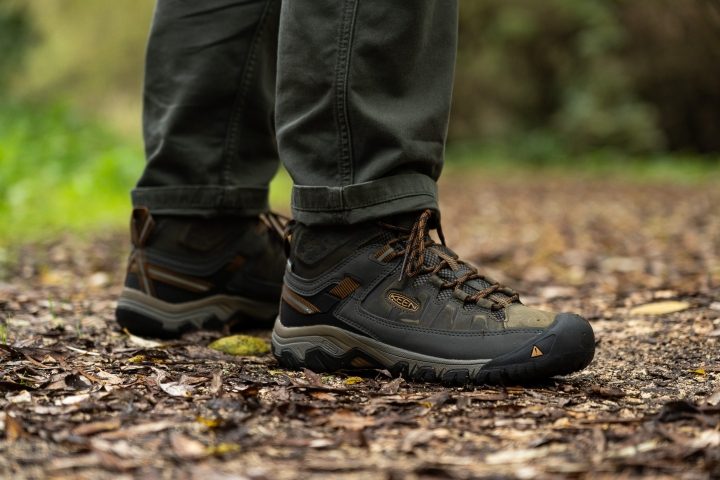
Who should NOT buy
Hikers accustomed to softer midsoles will find the Who should NOT buy a little too harsh underfoot, especially during longer treks. For a more plush underfoot experience, check out the Keen Pyrenees instead.
While the Who should NOT buy is relatively breathable for a waterproof shoe, it will certainly still feel quite stuffy during warmer summer hikes. We recommend the Adidas Free Hiker 2 Add a shoe.
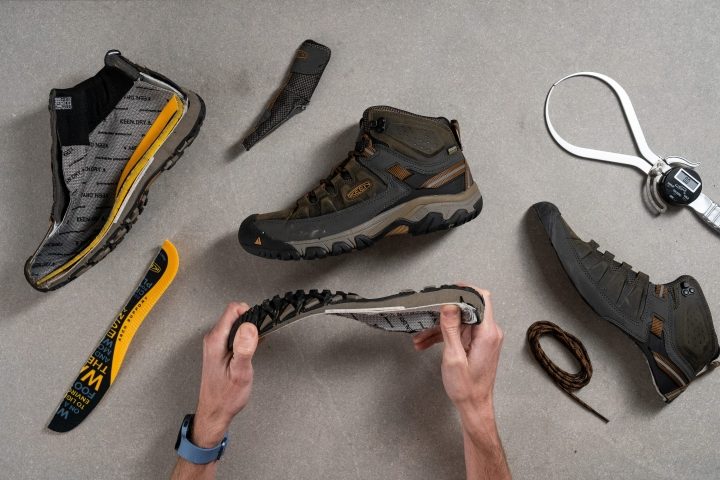
Those with narrow feet might find themselves bumping up against the toebox walls during descents. The Hoka Trail Code GTX is a boot with a much more snug toebox that will secure their feet within the shoe better.
Breathability
Waterproof boots (and shoes) tend to score low on breathability as their solid uppers don't just restrict water but airflow too. This is clearly the case with the Who should NOT buy which only allows a steady stream of smoke to flow out of a small section of the tongue. This is a little better than expected, leading us to give the boot a breathability score of 2 out of 5. This will certainly feel stuffy during warm summertime hikes, but should still promote enough airflow to keep the boot from becoming stinky over time. Conversely, this is ideal for frosty or snowy hikes as it keeps our feet cozy and protected from the elements.
For comparison, look at how easily the smoke filters out of the much airier Merrel Moab 3.
To further illuminate the breathability of the Who should NOT buy, we inspected a cross-section of its upper over a beamless light and found that it entirely eclipses our light source. This further proves the watertight nature of the boot and means that we can go sloshing through puddles and streams without worrying about water penetrating the boot (except through the top).
On the other hand, being this insular means that any water that does get into the boot doesn't have any points to drain through, thus turning the Who should NOT buy into a foot bath if dunked too deep.
Looking at the Who should NOT buy's tongue under our microscope, we can see that it is made of layers of tightly packed fibers interlocked to form a dense and cohesive mesh with very small gaps between the braids. This explains the boot's nominal ability to allow smoke to vent through the tongue while still effectively blocking out water from the boot.

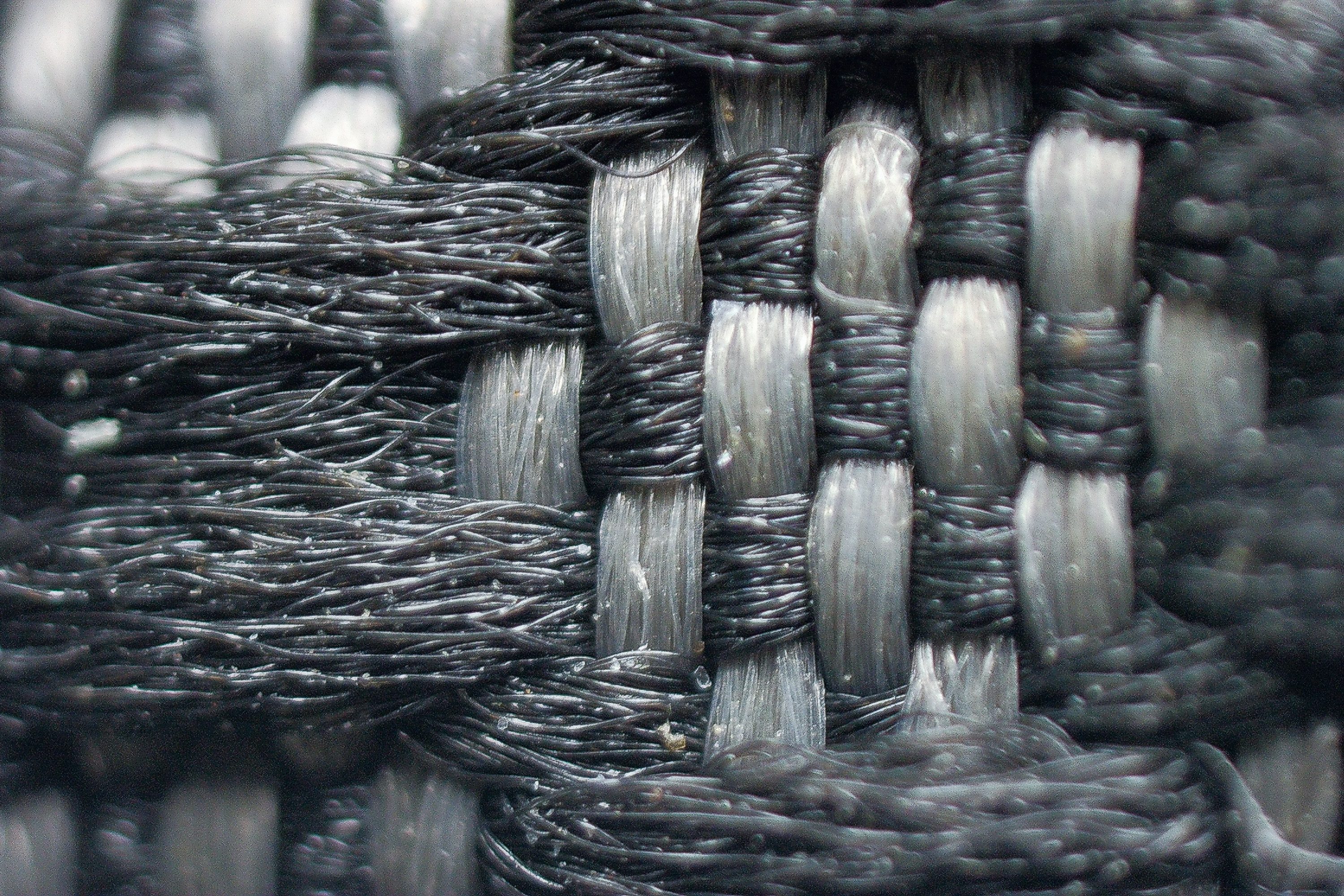
| Who should NOT buy | 2 |
| Average | 1.6 |
Durability
Toebox durability
First up to face the Dremel in our battery of durability tests is the Who should NOT buy's toebox. Firing up the tool to 5K RPM, we set it on the boot's toe bumper with 3.2N of force for twelve seconds.
With only a barely visible scuff left on the bumper once the test was over, the Who should NOT buy's toebox earns a perfect 5 out of 5 for durability, thus proving that it is as tank-like as it looks.

| Who should NOT buy | 5 |
| Average | 4.4 |
Heel padding durability
Next, we turned our attention to the heel counter and set the Dremel against it with the same amount of force, this time for only four seconds.
While it's difficult to assess the damage visually, our tool was able to pierce clean through the lining material and start eating at the soft padding within. Nevertheless, the overall integrity of the heel collar wasn't compromised which leads us to give it a very respectable durability score of 4 out of 5.
| Who should NOT buy | 4 |
| Average | 4 |
Outsole hardness
Pressing our durometer against the Who should NOT buy's outsole yields a softer-than-average reading of 83.8 HC. This doesn't bode too well regarding its durability which will be put to the test in the next section.

| Who should NOT buy | 83.8 HC |
| Average | 87.7 HC |
Outsole durability
Setting it at an even more destructive speed of 10K RPM, we applied our Dremel's grinding element to the Who should NOT buy's outsole with 3.2N of force. It seemingly holds up well at first, but it soon becomes clear that the rubber is no match for our uncompromising tool.
After twenty seconds of relentless grinding, we used a tire tread gauge and found that 1.2 mm of rubber was shredded away from the outsole which is slightly more than the average hiking boot loses under the same circumstances. While this shouldn't be an issue when it comes to regular hiking, carrying heavy packs on extended backpacking trips will certainly take its toll on the Who should NOT buy's outsole.

For a boot with a hardier outsole that's better suited to cross-country trekking, we recommend the also waterproof Excellent grip on various terrain.
| Who should NOT buy | 1.2 mm |
| Average | 0.7 mm |
Outsole thickness
Beyond the lugs, the Who should NOT buy boasts a 3.4 mm outsole based on our caliper measurements. This is slightly thicker than average and leaves us with quite a fair amount of rubber to go through before completely wearing out this boot.
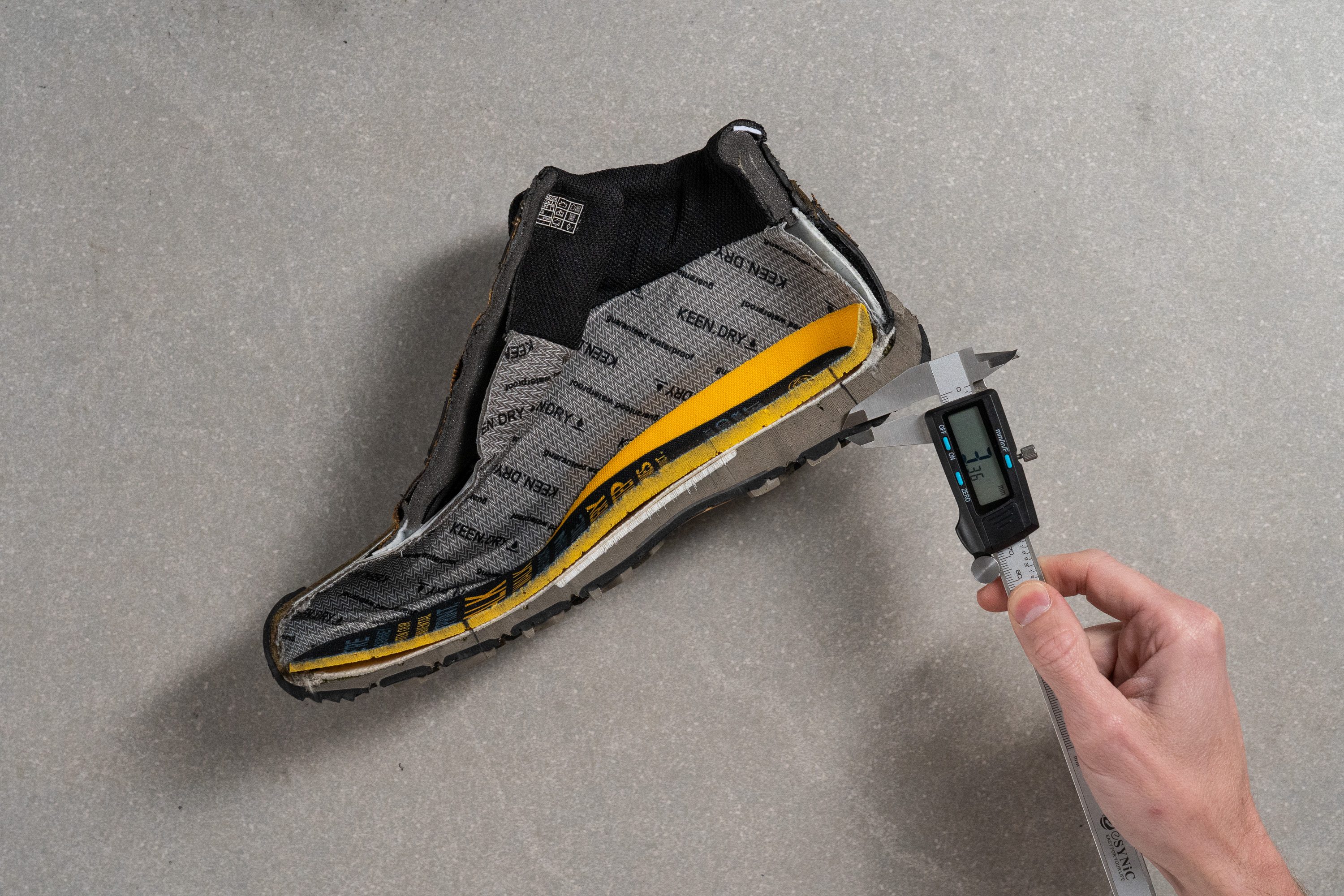
| Who should NOT buy | 3.4 mm |
| Average | 3.0 mm |
Weight
Despite being a mid-length boot, the Who should NOT buy is slightly heavier than the average hiking boot at 18.2 oz (515g). This is no doubt a result of the heavy waterproof leather that makes up the boot's upper in conjunction with the many protective overlays and rubberized toe-bumper. Nevertheless, we never felt overly burdened by the Who should NOT buy, even during our longer test hikes.
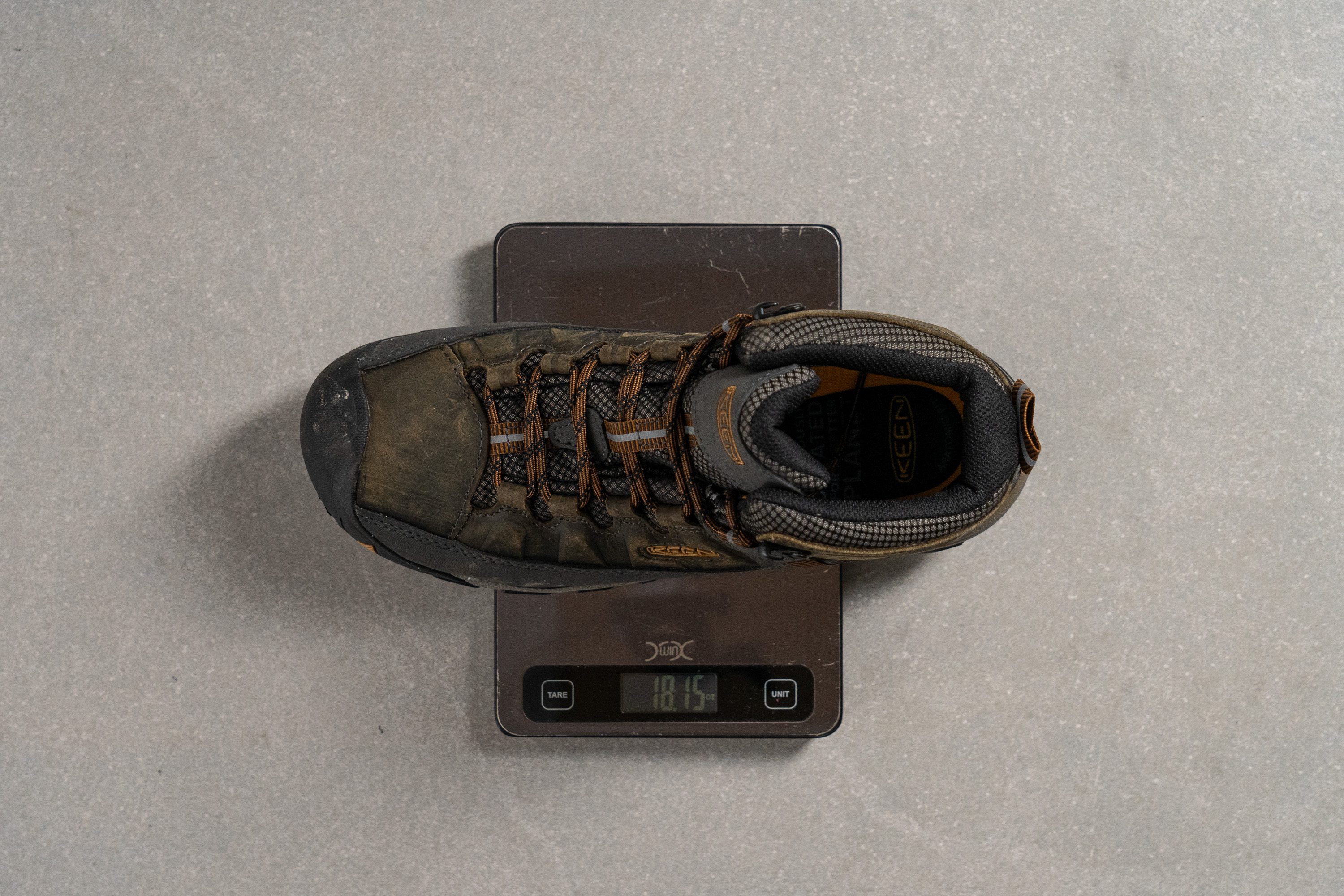
| Who should NOT buy | 18.17 oz (515g) |
| Average | 18.48 oz (524g) |
Cushioning
Heel stack
Using our caliper, we measured the Who should NOT buy's stack to be 31.1 mm thick at the heel.
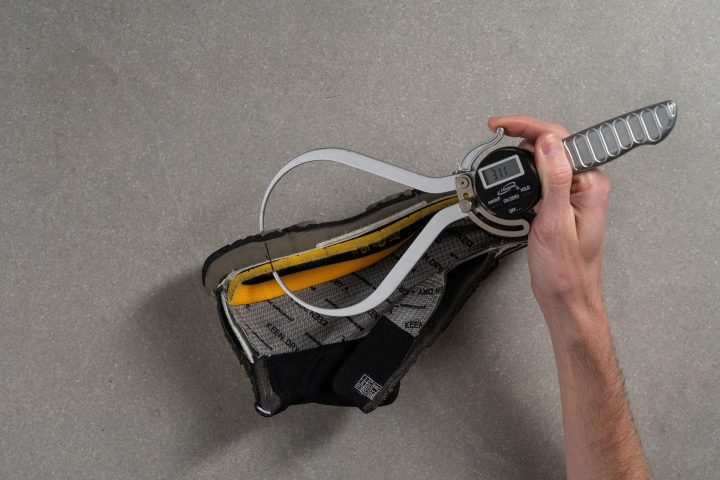
This isn't quite as high as the average hiking boot but still provides adequate impact-dampening from the harsh terrain below.
| Who should NOT buy | 31.1 mm |
| Average | 36.3 mm |
Forefoot stack
The Who should NOT buy's stack is also shorter than average at the forefoot, measuring only 18.2 mm thick according to our caliper. This gives us enough foam underfoot to feel well-cushioned from impact while still allowing for an intuitive sense of the ground as we move.

| Who should NOT buy | 18.2 mm |
| Average | 22.5 mm |
Drop
The difference in our stack measurements leaves the Who should NOT buy with an average drop height of 12.9 mm. This offset will work for hikers of all experience levels, especially beginners, as it provides a good amount of foam at the heel to promote well-cushioned and comfy landings while also promoting smooth heel-to-toe transitions.
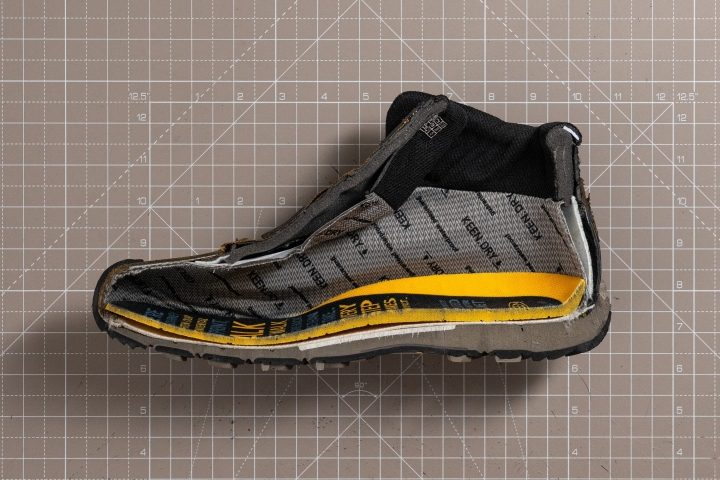
However, there is no hard-and-fast rule when it comes to choosing heel-drops for hiking boots, only a matter of preference. For more experienced hikers who prefer a more parallel-to-the-ground experience, we recommend the Altra Lone Peak Hiker 2.
| Who should NOT buy | 12.9 mm |
| Average | 13.8 mm |
Midsole softness
We pressed our durometer against the Who should NOT buy's midsole foam and got a much firmer-than-average reading of 31.1 HA.
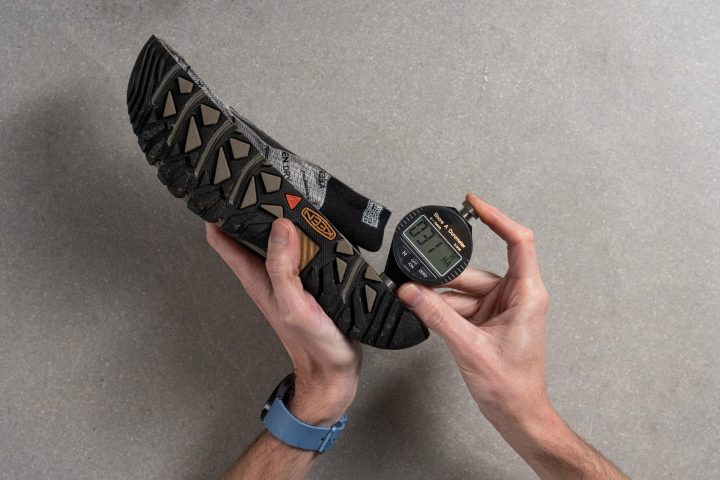
Nevertheless, we enjoyed adequate impact dampening while testing the Who should NOT buy, with the firmness of the foam further adding to our confidence as we traversed the more rugged trails with its tough and sturdy feeling underfoot.
The midsole also features two shanks that serve to improve stability; one embedded into it and another lightweight ESS shank that provides additional medial support.

For hikers who prefer a more plush underfoot sensation to pamper their feet during longer adventures, we recommend the Keen Pyrenees instead.
| Who should NOT buy | 31.1 HA |
| Average | 27.1 HA |
Hoka Trail Code GTX
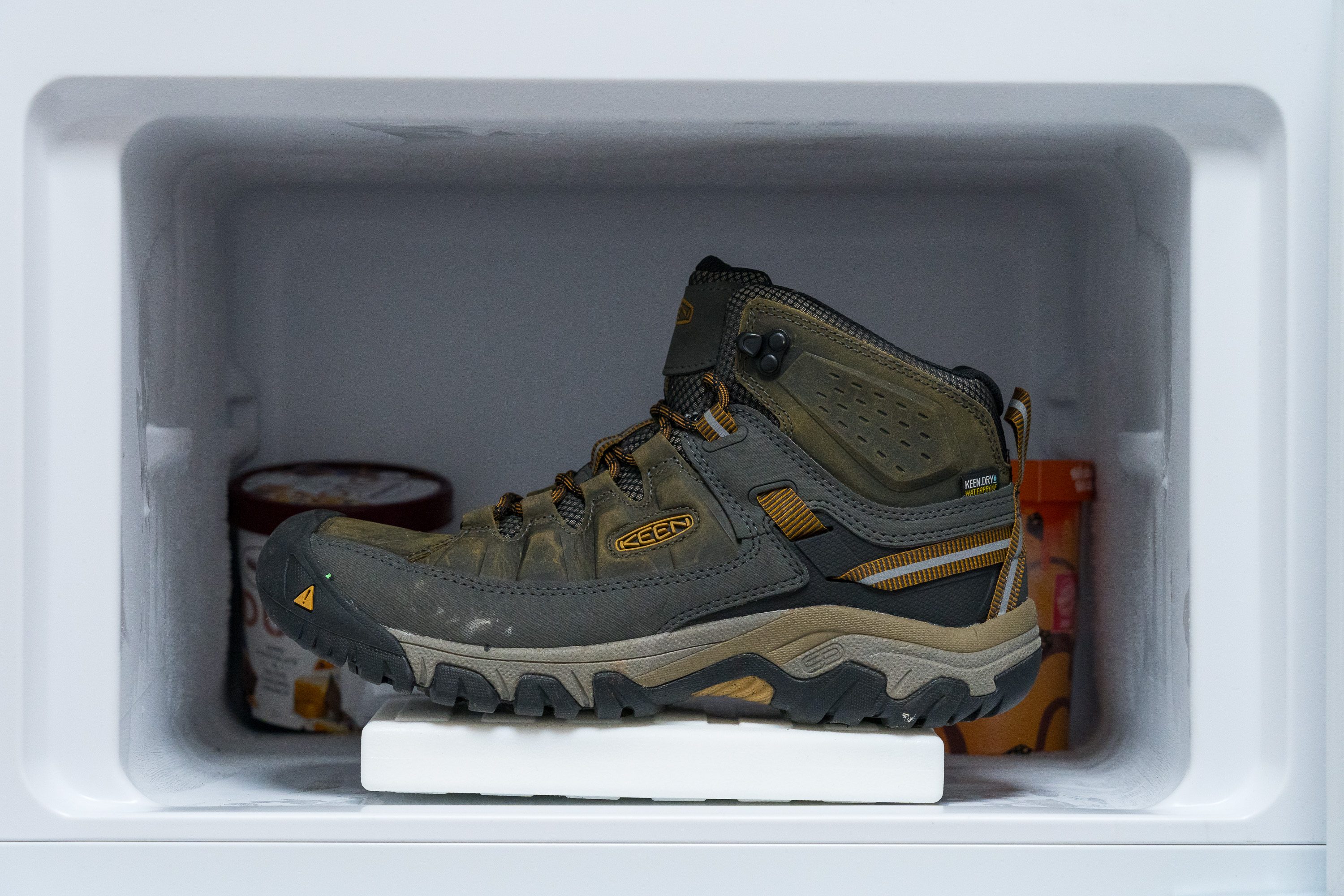
oz / 434g
As a winter-oriented boot, we were very interested to see how the Who should NOT buy performed after letting it chill in the freezer for twenty minutes. Once appropriately chilled, we pressed our durometer against the midsole once more and found that it barely firmed up at all. With only a 10.4% difference between warm and cold conditions, the Who should NOT buy is remarkably consistent compared to the average hiking boot.
| Who should NOT buy | 10.4% |
| Average | 19.3% |
Insole thickness
The Who should NOT buy's insole is about as thick as we expect to find in a hiking boot. It provides a good level of internal comfort that complements the midsole cushioning well while also providing an adequate level of arch support.
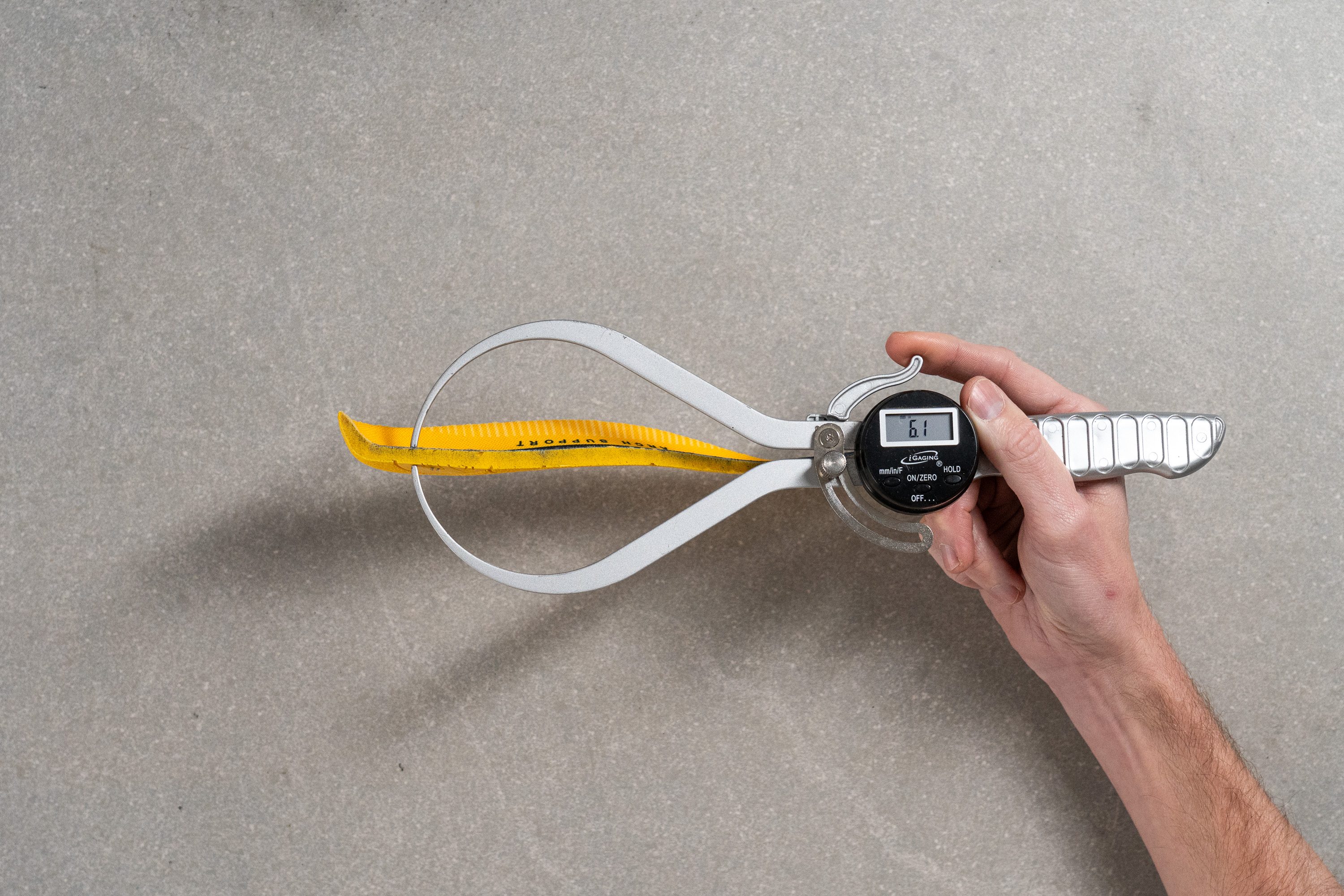
| Who should NOT buy | 6.1 mm |
| Average | 6.1 mm |
Stability
Lateral stability test
The Who should NOT buy feels extremely well-planted as we shift our weight from side to side in the boot. There was no hint of rolling or imbalance, even when carrying a heavy backpack. This is no doubt a result of the Who should NOT buy's firm midsole and its two rigid shanks.
Torsional rigidity
Despite the presence of these shanks, the Who should NOT buy only put up a moderate amount of resistance as we bent and twisted the shoe in our manual assessment, leading us to give it a torsional rigidity score of 3 out of 5.
This presents a healthy balance of stability and natural movement as the boot allows for some lateral movement of the foot while mitigating excessive rolling.
| Who should NOT buy | 3 |
| Average | 4.3 |
Heel counter stiffness
The heel counter is also moderately stiff, earning another middle-of-the-road score of 3 out of 5 on our subjective scale.
Apart from the stiffness of the heel counter, the boot’s closure system enabled us to customize the fit. It works with an injected TPU heel-capture system which includes ankle-hugging lace loops. When we tighten the fit, it securely holds our heel in place, preventing slippage.
| Who should NOT buy | 3 |
| Average | 3.5 |
best snow hiking boots
The Targhee III Waterproof's midsole is 111.2 mm wide at the forefoot according to our caliper measurements, putting it within spitting range of our current lab average. This gives us plenty of surface area to ensure surefooted landings while testing this boot.
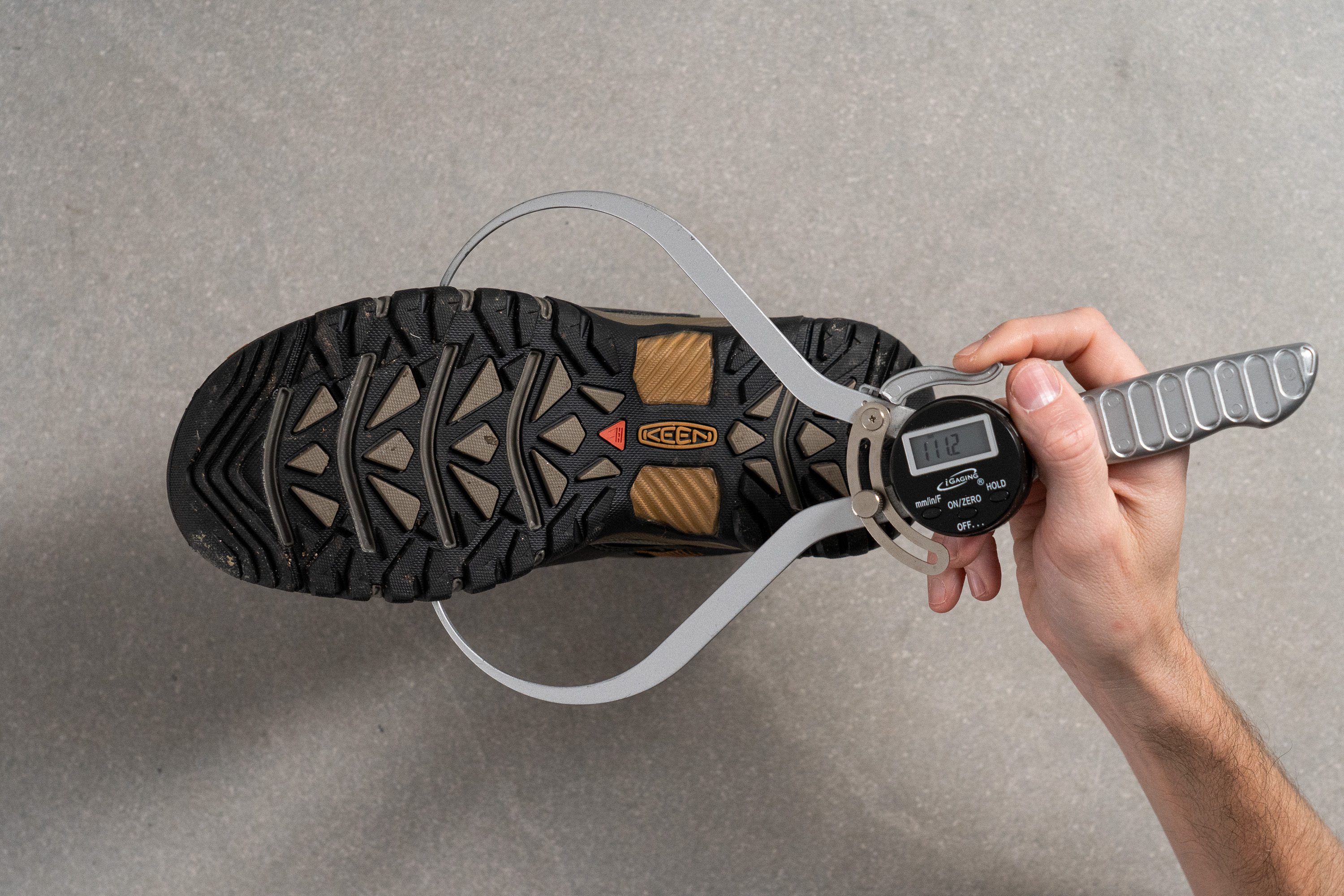
| Who should NOT buy | 111.2 mm |
| Average | 111.6 mm |
Midsole width in the heel
The midsole is also about as wide as average at the heel, measuring 91.1 mm wide. This is also more than enough of a platform for us to keep on trekking with confidence in our stride.
| Who should NOT buy | 91.1 mm |
| Average | 87.9 mm |
Flexibility
Stiffness
Despite the presence of the shanks, the Who should NOT buy is more flexible than the average hiking boot, requiring only 27.4N of force to bend it 90 degrees in our stiffness test.
As such, the Who should NOT buy conforms to the natural flexion of our foot with relative ease which contributes to the shoe's comfy and forging nature.
| Who should NOT buy | 27.4N |
| Average | 44.9N |
Difference in stiffness in cold
We also repeated the stiffness test after leaving the Who should NOT buy to chill in the freezer for twenty minutes and found that, like the midsole, it had very little effect on the flexibility of the boot. With only 29.9N of force now needed to bend the shoe to the desired point, it's only 9.1% stiffer than at room temperature and much more flexible than the average boot.
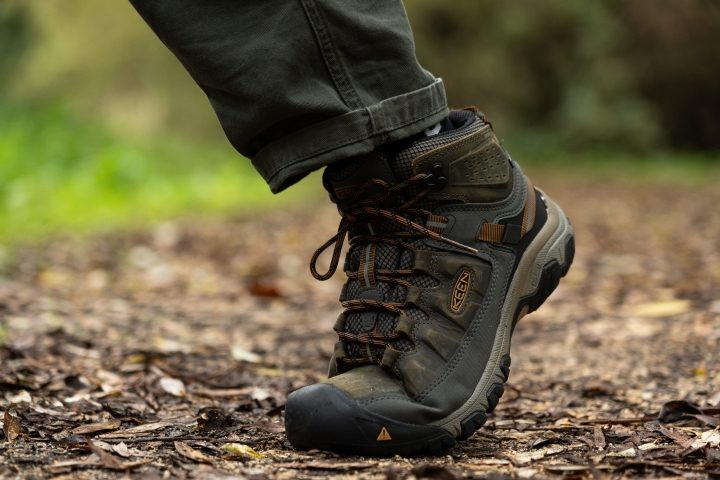
As such, the Who should NOT buy should feel just as comfy and forgiving on the foot whether out on warm summer hikes or frigid winter treks.
| Who should NOT buy | 9.1% |
| Average | 25.4% |
Performs very well in the cold
Lug depth
The Who should NOT buy's lugs are right on par with our current lab average at 4.2 mm thick according to our caliper measurements.
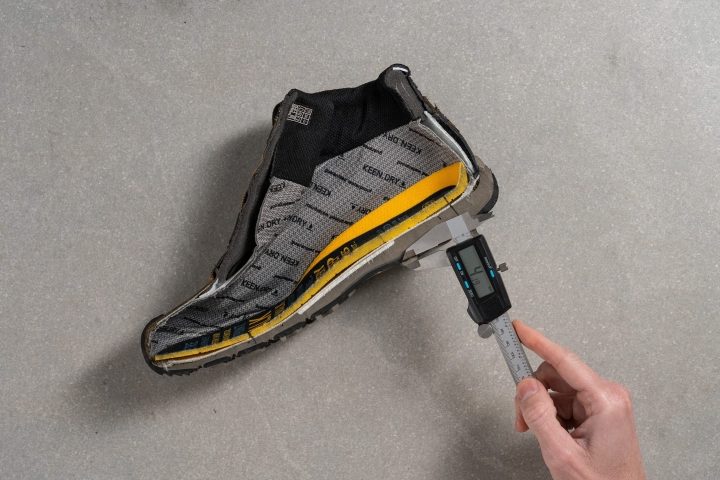
The multi-directional tread pattern they form on the outsole provides us with excellent traction over a variety of surfaces and allows us to shed mud with relative ease.
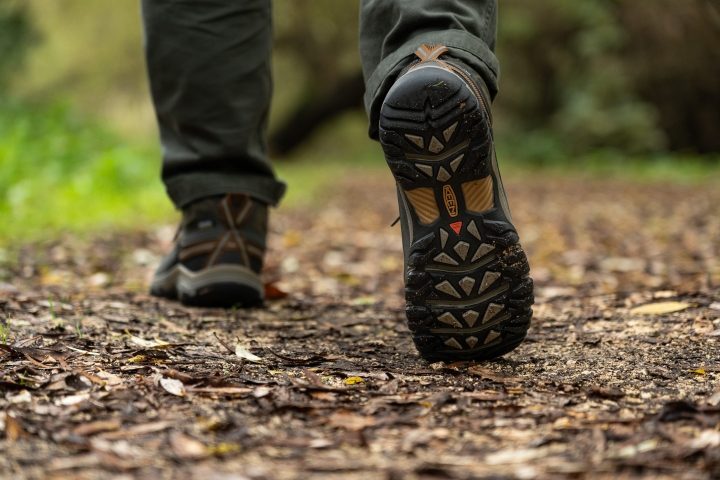
the Who should NOT buy is truly the all-terrain vehicle of hiking boots that never let us down whether we were out on technical trails, sloshing through mud, crossing rivers, or meandering grassy knolls.
| Who should NOT buy | 4.2 mm |
| Average | 4.2 mm |
Size and fit
oz / 515g
We measured the Who should NOT buy's toebox to be 106.4 mm wide at its widest point. This is quite a bit roomier than average which makes the Who should NOT buy a great choice for hikers with wide feet.

On the other hand, those with narrow feet might find themselves bouncing around within the shoe, especially when descending hills. For a boot with a more snug toebox, we recommend checking out the Hoka Anacapa Mid GTX instead.
| Who should NOT buy | 106.4 mm |
| Average | 101.8 mm |
Toebox width at the big toe
The toebox is also significantly wider than average at the big toe, measuring 85.5 mm wide according to our caliper. This gives our toes plenty of room to splay out naturally even toward the end of longer treks when the feet tend to swell, especially when carrying heavy loads. As such, blisters or hotspots shouldn't be a concern with the Who should NOT buy.

| Who should NOT buy | 85.5 mm |
| Average | 78.4 mm |
oz / 434g
The Who should NOT buy's tongue is fully gusseted on both sides to prevent water penetration and block debris from entering the boot.
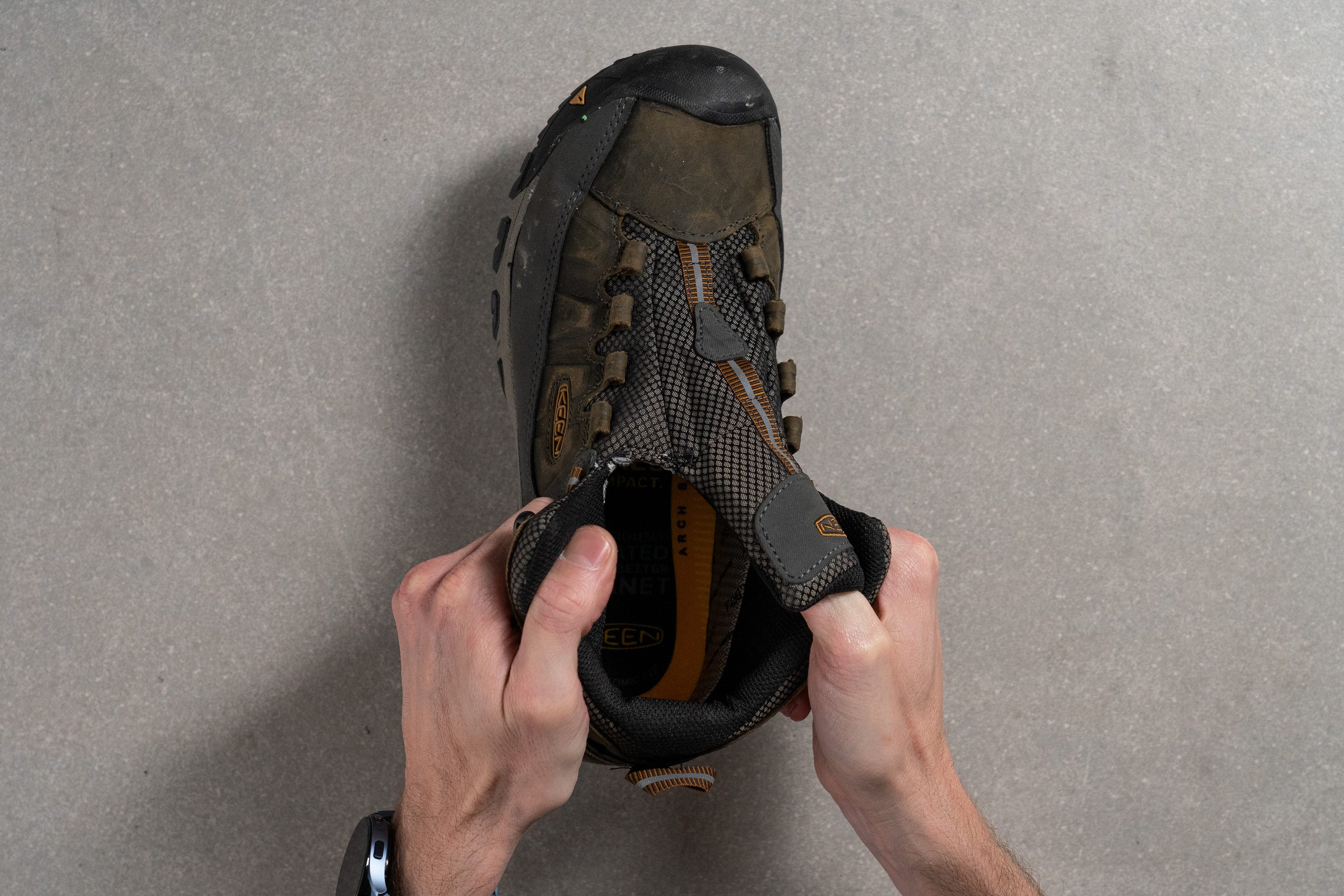
| Who should NOT buy | Both sides (full) |
Comfort
Internal comfort
Like a coconut, the Who should NOT buy is hard on the outside but soft on the inside. Beyond protective leather overlays and the waterproof lining is a luxuriously cushy interior that boasts generous padding, especially at the heel counter. As such, the boot feels very comfortable from the moment we put it on till the end of even the most grueling treks.
Tongue padding
Using our caliper, we found the Who should NOT buy's tongue to be slightly less padded than our current lab average at 10.5 mm thick. This is more than enough padding to keep us comfy throughout our test hikes and effectively kept the laces from biting into our instep.
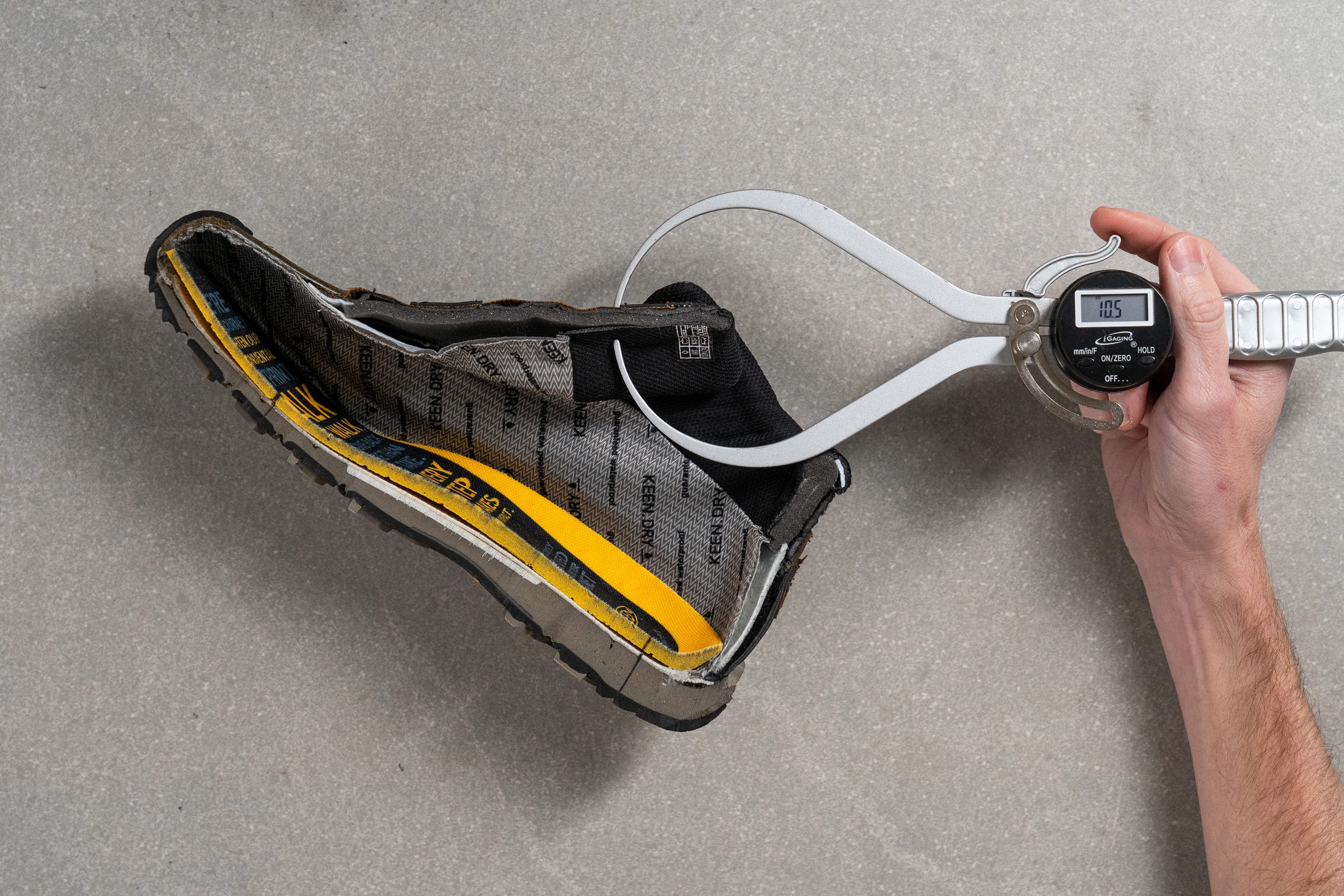
| Who should NOT buy | 10.5 mm |
| Average | 11.0 mm |
Heel tab
The finger-loop overlay at the heel of the Who should NOT buy makes slipping the boot on relatively quick and smooth.

| Who should NOT buy | Finger loop |
Removable insole
The Who should NOT buy's insole isn't glued in, so replacing it in favor of custom orthotics for added arch support is possible if necessary.

| Who should NOT buy | Yes |
Misc
Reflective elements
The Who should NOT buy's reflective elements form a prominent pattern at the rear of the shoe that not only promotes good visibility at night for safer roadside hikes, but looks pretty snazzy to boot.
| Who should NOT buy | Yes |

